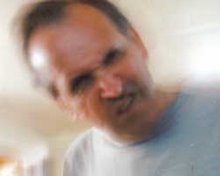Friday, October 31, 2008
Dad.
Posted by
Joe's History Barn
at
7:48 PM
0
comments
![]()
Labels: Just so you know.
Tuesday, October 28, 2008
No smoking.
Posted by
Joe's History Barn
at
7:30 PM
0
comments
![]()
Labels: Current Obsession. Rope.
Thursday, October 23, 2008
Sparkling sugar.
In one of many attempts to find out a little bit more about the history of rope I stumbled upon a short science piece making the rounds at all the news services. Seems scientists have discovered if you peel Scotch tape off it's roll in a vacuum it emits x-rays.
The article doesn't have any background, that is to say, what got the scientists unfurling tape in a vacuum anyway. Maybe it was a slow day, who knows.
Researchers at UCLA found that peeling Scotch tape off a pane of glass "ejects enough radiation to take an x-ray image."
The phenomenon is called triboluminescence and was first written about by Sir Francis Bacon in 1620 when he noted "It is well known that all sugar whether candied or plain, if it be hard, will sparkle when broken or scraped in the dark." Sounds like they played around with Lifesavers back then a bit. But that's just the idea. Many substances emit mild radiation when rubbed scraped and scratched.
The researchers above are thinking of using the energy to power portable x-ray machines. I'm sure someone else will come up something real fun to do with it.
In case you want to follow up, here's one link to the story: http://news.yahoo.com/s/ap/20081023/ap_on_sc/sci_scotch_tape_surprise
Posted by
Joe's History Barn
at
7:45 PM
0
comments
![]()
Labels: Crazy science
Tuesday, October 21, 2008
Gotta look up again, shit.
Just a shorty tonight, but in a rope-y theme. Seems the Peruvians had a thing for rope and what to do with it. Take the Rope Bridge of San Luis Rey. Built in 1350 across the Apurimac River, it was made of hand woven rope and spanned 148 feet.
The cables were twisted and then added as components of a larger cable until the core span was as thick as man's body. The bridge even had a device to self tighten the ropes as they stretched installed on one side.
So well made was this magnificent bridge it lasted 500 years. A lot longer, actually, than many cast iron bridges.
If you are intrigued check out Thorton Wilder's 1927 novel The Bridge of San Luis Rey, or if you prefer, find one of the several film adaptations. The most recent features Robert DeNiro and Kathy Bates.
Sorry readers, I tried to find at least a drawing of the orinal bridge but all I could dig up was endless DVD box art.
Posted by
Joe's History Barn
at
7:14 PM
0
comments
![]()
Labels: Current Obsession. Rope.
Monday, October 20, 2008
Look up, way up, and I'll call Angie and Fiddle
Doing research into expedition artists (the folk who paint and sketch the things that explorers go looking for before cameras were useful) landed me on quite few web sites devoted to things that fell from the sky.
There is a long history of objects pummeling the earth. Pretty much from ancient times onward man has seen stones, cinders, toads, fish (quite a few actually) and especially since air travel is common, the odd plane part and frozen poop.
And then there is meat. Seems that meat has fallen lots of times. Lets see starting in 1851 near San Fransisco troops reported seeing pieces of meat, apparently beef (how did they check?) falling from a cloudless sky.
Sampson County, North Carolina reported that in the same year meat as well as liver, brains and blood fell from the sky. No mention as to what cut of meat it was. Again in 1884 meat fell from the sky in Chatham County.
In 1869 on a farm near Los Nietos, California, more meat came down. This time in strips.
We move now to Bath, Kentucky when in 1876 cubes of beef (what else?) landed on the Crouch family farm.
Every meat fall occurred on clear cloudless days. Think I'll use the grocery store.
Posted by
Joe's History Barn
at
7:26 PM
0
comments
![]()
Labels: Just so you know.
Friday, October 17, 2008
Topsy
Posted by
Joe's History Barn
at
6:27 PM
0
comments
![]()
Labels: On this day.
Wednesday, October 15, 2008
Take a walk
Posted by
Joe's History Barn
at
6:38 PM
0
comments
![]()
Labels: Current Obsession. Rope.
Doink Doink
Today, or pretty close to it, (Oct 18th actually) marks the 50th anniversary of the video game. Robert Dvorak Sr and that crazy accordion player, William Higinbotham, displayed Tennis for Two at a Brookhaven National Laboratory lab open house.
William Higinbotham, a senior scientist at the Los Alamos research facility that developed the first atomic bomb was a key player in organizing scientists to ban the use of the bomb. He never felt good that he was remembered for helping birth the video gaming industry and not for trying to prevent nuclear proliferation.
Posted by
Joe's History Barn
at
6:28 PM
0
comments
![]()
Labels: On this day.
Friday, October 10, 2008
Spud nik
Posted by
Joe's History Barn
at
7:42 PM
0
comments
![]()
Labels: Just so you know.
Tuesday, October 7, 2008
Tied up.
Posted by
Joe's History Barn
at
7:34 PM
0
comments
![]()
Labels: Current Obsession. Rope.
Monday, October 6, 2008
Look up, way up, I'll call Rusty and Jerome . . .
Posted by
Joe's History Barn
at
5:15 PM
0
comments
![]()
Labels: Just so you know.
Wednesday, October 1, 2008
People's Painter
Posted by
Joe's History Barn
at
7:08 PM
0
comments
![]()
Labels: passings









